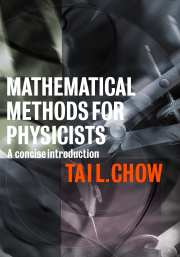Book contents
- Frontmatter
- Contents
- Preface
- 1 Vector and tensor analysis
- 2 Ordinary differential equations
- 3 Matrix algebra
- 4 Fourier series and integrals
- 5 Linear vector spaces
- 6 Functions of a complex variable
- 7 Special functions of mathematical physics
- 8 The calculus of variations
- 9 The Laplace transformation
- 10 Partial differential equations
- 11 Simple linear integral equations
- 12 Elements of group theory
- 13 Numerical methods
- 14 Introduction to probability theory
- Appendices
- Further reading
- Index
14 - Introduction to probability theory
Published online by Cambridge University Press: 04 August 2010
- Frontmatter
- Contents
- Preface
- 1 Vector and tensor analysis
- 2 Ordinary differential equations
- 3 Matrix algebra
- 4 Fourier series and integrals
- 5 Linear vector spaces
- 6 Functions of a complex variable
- 7 Special functions of mathematical physics
- 8 The calculus of variations
- 9 The Laplace transformation
- 10 Partial differential equations
- 11 Simple linear integral equations
- 12 Elements of group theory
- 13 Numerical methods
- 14 Introduction to probability theory
- Appendices
- Further reading
- Index
Summary
The theory of probability is so useful that it is required in almost every branch of science. In physics, it is of basic importance in quantum mechanics, kinetic theory, and thermal and statistical physics to name just a few topics. In this chapter the reader is introduced to some of the fundamental ideas that make probability theory so useful. We begin with a review of the definitions of probability, a brief discussion of the fundamental laws of probability, and methods of counting (some facts about permutations and combinations), probability distributions are then treated.
A notion that will be used very often in our discussion is ‘equally likely’. This cannot be denned in terms of anything simpler, but can be explained and illustrated with simple examples. For example, heads and tails are equally likely results in a spin of a fair coin; the ace of spades and the ace of hearts are equally likely to be drawn from a shuffled deck of 52 cards. Many more examples can be given to illustrate the concept of ‘equally likely’.
A definition of probability
Now a question that arises naturally is that of how shall we measure the probability that a particular case (or outcome) in an experiment (such as the throw of dice or the draw of cards) out of many equally likely cases that will occur. Let us flip a coin twice, and ask the question: what is the probability of it coming down heads at least once. There are four equally likely results in flipping a coin twice: HH, HT, TH, TT, where H stands for head and T for tail.
Information
- Type
- Chapter
- Information
- Mathematical Methods for PhysicistsA Concise Introduction, pp. 481 - 505Publisher: Cambridge University PressPrint publication year: 2000
